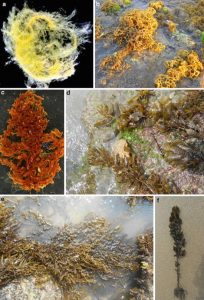Class: Phaeophyceae
General Characteristics
- Phaeophyceae which is commonly known as Brown Algae constitute a diverse group of multicellular organisms.
- Brown algae consist of approximately 16 orders with 1800 species that are grouped into 285 different genera.
- Brown algae are kept in the phylum Heterokonta
- Brown algae are found in marine habitats and brackish waters while a few species are found in freshwater as well.
- These are characterised by the brown colour that comes from a carotenoid pigment, fucoxanthin which is present in their chloroplasts and in some species, various phaeophycean tannins. The chloroplasts also have chlorophylls a, c 1, and c 2, β-carotene, diatoxanthin, violaxanthin and large amounts of fucoxanthin.
- The structural component of the cell wall is composed of cellulose microfibrils.
Cell Structure
Cell Walls
- The cell wall is generally gelatinous and consists of two layers of which cellulose is the main structural skeleton.
- The main components of phaeophycean cell wall are polysaccharides such as Algin, Fucoidin and Fucin.
- Alginic acid is β1,4 linked mannuronic acid units while Fucoidin is α-1,2 linked sulfated-fucose units.
- Plasmodesmata or pores are also present in cell walls and are bounded by plasmalemma.
- The parenchymatous Phaeophyceae have plasmodesmata or pores are grouped into pit areas whereas in the more primitive ones are scattered in the cell wall.
Chloroplasts, Plastids, Pigments and Photosynthesis
- The chloroplasts are usually discoid and are surrounded by an envelope.
- The outer membranes of the chloroplast endoplasmic reticulum may be continuous or
discontinuous depending on the species. - The pigments are located in plastids and chloroplasts also consists of chlorophyll a, c 1, and c 2, β-carotene, violaxanthin, diatoxanthin and large amounts of fucoxanthin.
- Laminarin is stored in endoplasmic reticulum outside the chloroplast.
- D-mannitol is aggregated through photosynthesis and is affected by change in salinity as well as light conditions.
Phlorotannins and Physodes
- Brown algae have a characteristic feature ie. the presence of Physodes.
- Physodes are colourless vesicles present in large numbers with highly refractive acidic fluid staining red with vanillin and hydrochloric acid In the meristematic, photosynthetic and reproductive cells
- Physodes store phlorotannins which are manufactured by Golgi in the perinuclear area of the cell.
- These phlorotannins are non-glycosidic proteins which oxidize in the air forming phycophaein which is a black pigment. This gives Phaeophyceae members their characteristic black colour.
- The phlorotannins absorb ultraviolet radiation and also act as antifoulants in cell walls and also contribute to wound plug development.
Thallus Organization
- Phaeophyceae are mostly lithophytes, which require stable hard substrata for attachment, and a number of the filamentous, smaller species are epiphytes.
- The freshwater Phaeophyta species are filamentous and smaller in size whereas the marine species have complex and bulky thalli.
- The size may vary from small filamentous forms like Ectocarpus and Hinskia to massive intertidal weeds such as Ascophyllum and Fucus to subtidal large kelps and the largest seaweed known Macrocystis pyrifera.

Reproduction
Phaeophyceae reproduction ranges from by vegetative, asexual and sexual methods of reproduction.
Vegetative Reproduction
- Brown algae show vegetative reproduction via fragmentation and propagules are found in members of sphaecelariales.
Asexual Reproduction
- Asexual reproduction mostly occurs in brown algae with a few exceptions of Tilopetridales, Dictyotales and Fucales.
- Asexual reproduction occurs in ectocarpales and spherocarpales via biflagellate zoospores that later develop into reproductive organs called sporangia which could be unilocular or plurilocular as observed in Hinskia mitchelliae.
- Ectocarpus produce Gametes parthenogenetically to form asexual progenies. Asexual reproduction is not found in Laminaria.
Sexual Reproduction
- Sexual reproduction takes place in Phaeophyceae by the formation of flagellate gametes that are formed inside gametangia.
- Some brown algae are formed by multicellular gametangia.
- The haploid thalli form ranges from isogamous, anisogamous to oogamous
- The sexual reproduction occurred by the fusion of flagellated male and female gametes or by fusion of flagellated male and large non-flagellated female gametes.
- Brown algal life cycle shows alteration of generations of both haploid and diploid organisms.
Economic Importance
- Brown algae are used as food and is consumed either raw or cooked. Seaweeds have been used due to their high nutritive value as these are highly rich in protein, carbohydrate, vitamins, minerals and amino acids etc.
- These can partially be replaced for conventional proteins in poultry feed and can be used to feed horses, cows and pigs.
- Algin and Alginates can be used for industrial purposes. These are mainly used in the food industry paper industry, explosives, polishes, ceramics, toys and baking industry. Alginates are used as suspending agents in pharmaceutical products.
- Brown algae are also used as green manure due to its easy availability, low cost, nutritional
quality, rich micronutrients, macronutrients, vitamins, growth hormones and chelating property. - Brown algae have also medicinal properties including goitre cure, ulcer cures, antioxidants and for impurity elimination and balancing skin pH.
- Algae can also produce biofuels using water and carbon dioxide. Seaweed species such as Sargassum and Laminaria are used for bioethanol production.
References
- https://www.sciencedirect.com/topics/agricultural-and-biological-sciences/phaeophyceae
- Phycology Fourth edition Robert Edward Lee, 2008
- https://www.researchgate.net/publication/225443405_Effect_of_seaweed_liquid_extract_on_growth_and_yield_of_Triticum_aestivum_var_Pusa_Gold